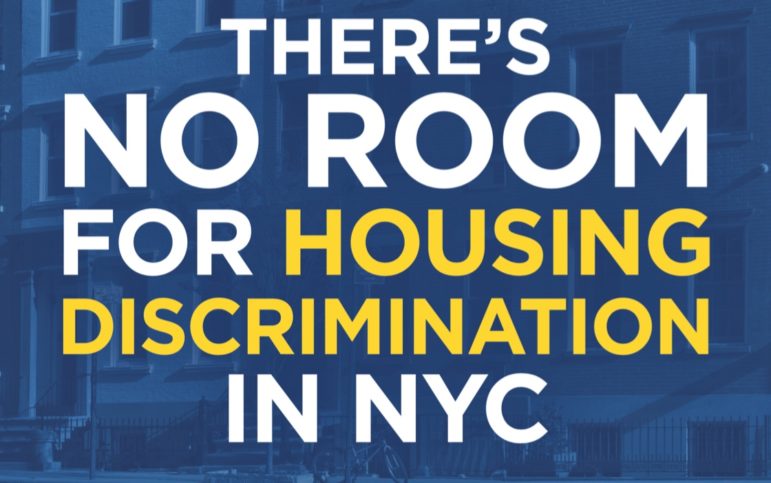
Opinion: Bias Fuels Source of Income Discrimination
“…much of the documented illegal discrimination is based on fears, bias, and stereotypes about the people who possess the rental subsidies and has less to do with the structure of the subsidy programs.”
NYC Commission on Human Rights
A poster aimed at curbing housing discrimination.
CityViews are readers’ opinions, not those of City Limits. Add your voice today!
Neil Garfinkel, counsel for the Real Estate Board of New York (REBNY), penned an op-ed in March and made the mendacious assertion that poorly run subsidy programs are the “main cause” for the harm inflicted on subsidy holders who encounter source of income discrimination.
Perhaps prior to writing this op-ed, he should have consulted with actual subsidy holders or people who are tasked with enforcing fair housing laws. Had he done so, he would have learned that much of the documented illegal discrimination is based on fears, bias, and stereotypes about the people who possess the rental subsidies and has less to do with the structure of the subsidy programs.
Source of income discrimination is still quite pervasive in New York City despite the passage of laws at the city and state level prohibiting it. Landlords, management companies, real estate brokers, and agents understand rental housing subsidies are provided to eligible lower income individuals and families, disproportionately tenants of color, tenants with disabilities, and single female-headed households with children. These are rent-burdened households who, absent a subsidy, might not be able to afford market rents.
Here are some examples of what the Fair Housing Justice Center (FHJC) has seen in recorded undercover testing investigations and fair housing litigation:
Outright refusals to rent, even when the asking rent is within rent payment standards and the tenant has a 100 percent subsidy which guarantees payment of all the rent directly to the landlord.
Segregated and unequal listings: A broker who told people with subsidies that the rental ads in their window were for “regular” people and there was a separate set of listings for “program” people. Many of the listings available to subsidy holders were not up to code and in such disrepair that they would not likely pass an inspection.
Dual and discriminatory rental processes: A major landlord maintained a dual track for prospective applicants. Tenants with subsidies were directed to an office where they spoke to an agent through a plexiglass window and were told to fill out a rental application that would allow them to be placed on a waiting list for a future available apartment. In contrast, tenants without subsidies were directed to a different leasing office and met with a leasing agent around a conference table and were immediately taken to view available apartments for rent before completing an application.
Comments from housing providers based on stereotypes about people with subsidies being lazy, contributing to increased crime, or being too poor to keep their apartments clean, making them a perceived threat to the health and safety of other tenants. Even though many households with subsidies do work, sometimes more than one job, another landlord commented that he preferred to only rent to “professional people” who work 9-5.
Not too many years ago, we saw evidence of this prejudice against people with lower incomes in some mixed-income housing developments. One developer set up a separate entrance or “poor door” for use by occupants of the affordable housing units. Other providers deemed tenants occupying affordable units as undeserving and denied them access to some of the common amenities in the buildings. So, bias against and mistreatment of lower income New Yorkers is not just felt by households with housing vouchers.
To be sure, we all want housing authorities or other agencies to modernize and become as efficient as possible for the benefit of tenants and landlords. Some have made strides in that direction. But to suggest the failure to do this accounts for the widespread discrimination against households with rental subsidies is simply not the way to begin an honest discussion about this issue.
Housing providers must do business in the real world and comply with various regulations and laws that govern their activities. The overriding public interest and need to reduce housing insecurity for households at greatest risk of homelessness far outweighs any landlord inconvenience or insecurity about variations in housing subsidy programs. And, to the extent distinctions exist in the way local, state, and federal rental subsidy programs operate, this is another cost of doing business and certainly no reason to prevent otherwise qualified tenants from obtaining housing.
Mr. Garfinkel also bemoans the fact that voucher holders must wait for what he terms an “unnecessary, mandated inspection process.” While we can agree that the required inspections need to be as timely, efficient, and thorough as possible, they are essential. Given the billions in taxpayer dollars spent annually on the provision of housing subsidies in this country, we need to ensure that tenants using the subsidies are able to secure decent, safe, and sanitary housing.
As a renter, I wish there were more consistency, greater efficiencies, and standardized policies and practices among the hundreds of thousands of private rental housing providers in New York City. Renters are expected to engage in a time-consuming, costly, and anxiety-producing search process that involves navigating a confounding and complex maze of landlords, management companies, and real estate agents in the hope of finding one suitable, decent, and affordable housing opportunity.
As a friend of mine put it, “looking for an apartment in New York City is a little like Navy SEAL training, it is intense.” And he was not looking for an apartment using a rental subsidy. People with rental subsidies go through the same intense process while additionally enduring multiple acts of source of income discrimination during their search. Instead of focusing exclusively on how housing subsidy programs operate, Mr. Garfinkel and REBNY should take affirmative steps to combat the bias that drives much of the rampant source of income discrimination within the rental market.
Fred Freiberg currently serves as the national field consultant for the New York City-based Fair Housing Justice Center (FHJC).
The post Opinion: Bias Fuels Source of Income Discrimination appeared first on City Limits.


